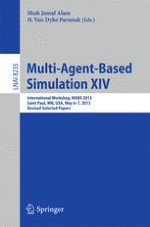2014 | OriginalPaper | Buchkapitel
Validating Simulated Networks: Some Lessons Learned
verfasst von : Shah Jamal Alam, S. M. Ali Abbas, Bruce Edmonds
Erschienen in: Multi-Agent-Based Simulation XIV
Verlag: Springer Berlin Heidelberg
Aktivieren Sie unsere intelligente Suche, um passende Fachinhalte oder Patente zu finden.
Wählen Sie Textabschnitte aus um mit Künstlicher Intelligenz passenden Patente zu finden. powered by
Markieren Sie Textabschnitte, um KI-gestützt weitere passende Inhalte zu finden. powered by
